This article describes the appeal hearing before the Oklahoma City Board of Adjustment on Thursday, May 20, 2010, between 1:30 - 5:20 p.m. The contestants are Preservation Oklahoma, appealing from Oklahoma City's Downtown Design Review Committee's decision to permit SandRidge Energy Company to destroy 5-6 buildings, 5 of which are considered historic by some (and some more than others), to make way for its planned SandRidge Commons development. SandRidge defends that decision in this hearing.
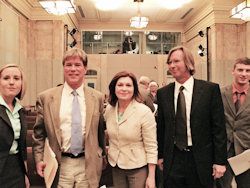 If SandRidge was either expecting or hoping for a hearing that would go as smoothly as did the DDRC hearing at which it won a hands-down victory (and notwithstanding Anthony McDermid's "Blood on our hands" remark), it didn't happen. This board had serious questions, only some of which were discussed during the meeting. The mere facts that the appeal did not get out-of-hand denied (but was instead continued for further deliberation) and that most if not all board members had lots of serious questions and concerns, and, further, gave no sign of being influenced by the who's-who that SandRidge had lined in support of its position, Preservation Oklahoma must certainly be seen as the winner of this round — even though the ultimate outcome is far from decided. But, on this day, Preservation Oklahoma more than adequately held its own against SandRidge Energy.
If SandRidge was either expecting or hoping for a hearing that would go as smoothly as did the DDRC hearing at which it won a hands-down victory (and notwithstanding Anthony McDermid's "Blood on our hands" remark), it didn't happen. This board had serious questions, only some of which were discussed during the meeting. The mere facts that the appeal did not get out-of-hand denied (but was instead continued for further deliberation) and that most if not all board members had lots of serious questions and concerns, and, further, gave no sign of being influenced by the who's-who that SandRidge had lined in support of its position, Preservation Oklahoma must certainly be seen as the winner of this round — even though the ultimate outcome is far from decided. But, on this day, Preservation Oklahoma more than adequately held its own against SandRidge Energy.The sound files from the hearing, as well as photos and personal observations, appear below.
SOUND FILES. My attempt to download the video file of this hearing failed as to the video but succeeded as to the sound files. Although the sound files are audible and understandable, the quality is poor — but at least you can hear what was said by all involved. I have broken that part of the BOA's May 20 meeting into four consecutive parts, cutting out the parts of the meeting that don't pertain to the hearing. Beyond the synopsis information below, additional observations and comments, as well as some photos, are set forth following the audio files.
| Part 1 — 59 minutes, 15 seconds Preliminary Matters  |
| Synopsis. Includes recusal by board member Jeff Austin; statement by board member David Wanzer that his wife is an attorney with McAfee & Taft but that she has not worked on appeal and that her relationship with McAfee & Taft will have no impact on his ability to to hear the appeal objectively and render an unbiased decision; other preliminary matters; replay of the April 8, 2010, Downtown Design Review Committee video. |
| Part 2 — 44 minutes, 53 seconds The Appellant's Presentation  |
| Synopsis. Includes presentations by Suzette Hatfield, Preserva- tion Oklahoma board member; Katie Friddle, Executive Director, Preservation Oklahoma; and Barrett Williamson, Norman architect. |
| Part 3 — 46 minutes, 40 seconds The Applicant's Presentation  |
| Synopsis. Includes presentations by Marsha Wooden, Vice President of Administration, SandRidge Energy; Frank Hill, attorney for SandRidge; Rob Rogers, lead architect, Rogers Marvel, New York City. |
| Part 4 — 50 minutes, 34 seconds Floor Speakers, Discussion, and Continuance  |
| Synopsis. Includes individual presentations by Jonathan Poston and Nick Roberts on behalf of the appellant and by Mark Beffort and Carrie Watson on behalf of the applicant. All speakers concluding (at around 21:25 above), considerable discussion occurred about the absence of structural engineering studies, and, later, if any need existed for the same, and whether or not a historic assessment study would occur to be paid for by the Historic Trust (as it offered to do). Lots of confusion. The short story is that the parties agreed to continue the hearing without condition until June 17 at which time all issues remain up for grabs, so to speak. For much more about this, see Who's On First, below. |
EXPERIENCES & OBSERVATIONS. Thinking I might need to get there early to get a good seat, I arrived at about 1:00 p.m. after taking in a great lunch (Spaghetti Marinara at the Steak & Catfish & Italian Kitchen restaurant at 305 N. Walker). When I arrived and to my surprise, only 3 or so others were milling around in anticipation of the meeting and the City Council chambers were dark — I wondered if I was in the right place or at the wrong time. Seeing the SandRidge Commons model (below) and a Board of Adjustment agenda outside the City Council chambers, I figured that I was just early.
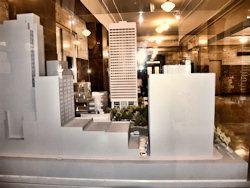 | 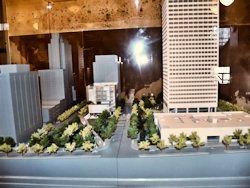 |
More people starting showing up outside City Council chambers and I said hello to a few that I knew — including Frank Hill. Frank is a very fine and prominent lawyer, one of the most respected in the city. He is a partner in McAfee & Taft and we've been acquainted since he was the leader in my son's cub scout program lo so many years ago. My son is now 41 years old if that gives the picture. I was surprised when I "reintroduced" myself saying, "You may not remember me but I'm ..." and it pleased me that he did. It was also a pleasant surprise me when he said, paraphrased, "You've been blogging about this matter, haven't you?" "Yes, I have," I replied, probably with a grin on my face. Although I didn't know it at the time, Frank was the lead presenter for the SandRidge position at the meeting which would shortly begin.
Eventually, the lights inside City Council chambers were turned on and I took a seat on the right side, front bench/pew. A person (City Clerk, I think) started putting name plates for BOA members and eventually BOA Chair Rod N. Baker called the meeting to order at around 1:35 or so.
 | 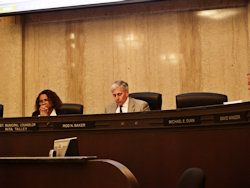 |
As people took their seats and the area became fairly full of people, it became evident that most, not all, people were sitting on either the left or right column of pews depending upon whether they favored or disfavored Preservation Oklahoma's appeal. Generally, those seated in the west column were pro-SandRidge and those seated in east set of pews were pro-Preservation Oklahoma.
East Side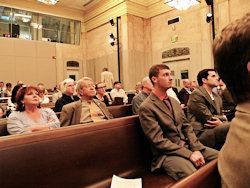 | East Side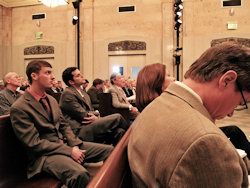 |
| West Side Frank Hill on the isle, then Bob Rogers, NYC Architect 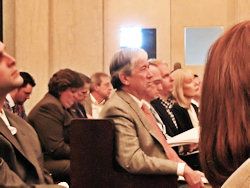 | |
When posting this article initially, I said, "I didn't take many notes during the meeting so some of what I'm saying below may be not exactly correct — but I'm trying to be as faithful to accuracy as I can." Now, having listened very closely to the audio transcription of the meeting (above), I have much greater confidence in my reporting and have made a few amendments and corrections.
When the appeal came up on BOA's agenda, the first thing that happened was that BOA member Jeff Austin recused (withdrew from participation) without giving an explanation. Ordinarily, in ordinary court proceedings, a judge will recuse for reasons such as an actual or potential conflict of interest, personal and/or business familiarly with one or both of the litigants or some other cause that might give rise to impropriety or the appearance of impropriety. Whatever the reason, that reduced the number of sitting BOA members to 4, a majority of 3 being required for decision. BOA member David Wanzer announced that his wife was an attorney with McAfee & Taft, the firm representing SandRidge, but he said that she had not worked on this matter and that her relationship with the law firm would not affect his objectivity and that he was able to and would render an unbiased decision in the matter.
Finally, after dealing with other agenda items, the appeal proceedings began, probably around 2:00 - 2:10. As the appealing party, Preservation Oklahoma led off. Three spoke in behalf of the appeal — Suzette Hatfield, board member of Preservation Oklahoma; Katie Friddle, its executive director; and Barrett Williamson, a Norman architect who formerly lived in Oklahoma City.
Suzette Hatfield | Katie Friddle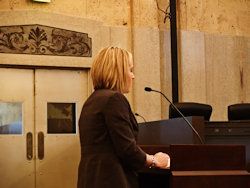 |
Barrett Williamson | |
That done, SandRidge then presented its case. Although there were also three speakers, only two presented substantive discussion, Frank Hill and Bob Rogers. The third, Marsha Wooden, SandRidge's Vice President of Administration, merely served to introduce Frank Hill and a few others who did not speak during the meeting.
Frank Hill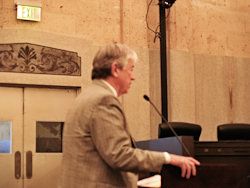 | Bob Rogers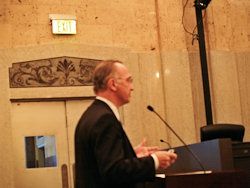 |
With those primary presentations being made, and as 5:00 p.m. was drawing nigh, others had signed up to talk and Chair Rod Baker cautioned them that they should keep their remarks brief since 5:00 p.m. was fast approaching. Actually, one board member, Jim Allen, announced that he had to leave at 5:00 so if the session continued much beyond that then he'd not be there to vote at all. This information was assimilated and acted upon by all but one of those who remained to speak.
I didn't get pictures of the pair that spoke in favor of SandRidge's position — one was Mark Beffort, the lead partner for the same group that owns Leadership Square, Oklahoma Tower and Corporate Tower. As noted in a comment following this article, he objected to the notion that someone could force a building onto the national register without the owner's consent (even though the appellant did not take that position). Too, he expressed his view that the properties involved did not lend themselves to office use. Overall, his tone struck me as rather defensive. The other speaker was Carrie Watson with the Oklahoma City National Memorial & Museum. Her comments were rather general, I thought, but you can judge for yourself.
A pair of speakers rounded out the position of those favoring Preservation Oklahoma's position: Jonathan H. Poston, Director of the Southwest office of the National Trust for Historic Preservation, and Nick Roberts, blogger at Downtown On The Range.
Jonathan Poston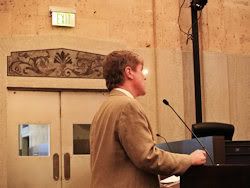 | Nick Roberts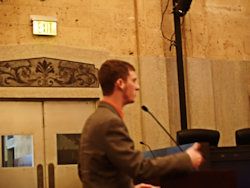 |
Poston's presentation was succinct, to the point, and delivered powerful support to the appellant's position. Of all presentations made during the meeting, I rank his as scoring the most points and being of the highest caliber in terms of content and presentation. On behalf of the National Trust for Historic Preservation, he offered to pay for a historic study of one or more of the buildings involved (the number was not clear to me) and left the door open to pay for structural stability studies, as well.
Nick's presentation, while fine, ignored two or three interruptions by Chair Rod Baker that it might be a good time to stop. When writing this article initially, I incorrectly said that "Nick offered a compromise that would willingly throw the India Temple building under the bus in favor of placing SandRidge's proposed new building on that same location." In saying that, I was mistaken — what he actually said was that the building that SandRidge proposes to build could be built east of its proposed location and the the India Temple building could be preserved, as well. But ... when the Chair says it's time to stop, even if courteously made (as it was), an effective speaker will learn to take the cue and zip it. In the courtroom, I can assure you that a judge would be much less courteous if the suggestion were not taken.
After all presentations and sign-up speakers were done, that's kind of where the fun began ... coming up next.
| WHO'S ON FIRST, or WHAT THE HECK HAPPENED, or WHAT IN THE WORLD WILL HAPPEN NEXT? It's hard picking a subtitle for this section. I've listened to the complete hearing 4 times now, and, more particularly, that part of Part 4, above, the BOA's discussion following all speakers about 7-8 times. That said, I'm still not clear about what happened or what the rules of this proceeding were-or-are as they relate to the appeal. I will be completely amazed if many, if not all, don't suffer some degree of a Tom Hank's "brain cloud" condition when trying to identify precisely what those rules were or are and/or their absence or lack of clarity thereof. Only when city planner Susan Miller spoke toward the end of the long afternoon was some degree of clarity and focus achieved, and, even then, reasonable minds can and probably will differ as to the amount thereof. Read on and see what I mean ... Staff Report. The Board of Adjustment Staff Report for this meeting states that, The Committee recommended approval of the application based on:Structural Engineering and/or Historical Assessment Studies. Possibly based on that statement of reasons, three or four of the four committee members expressed concern that the record did not include any structural engineering studies that the board could consider — and SandRidge acknowledged that it didn't have any such studies. The point was first raised by board member Jim Allen before the individual speakers made their remarks, but, after they were completed, member Jim Allen moved that the meeting be continued (initially he said "for at least 30 days"): Jim Allen: I've heard both sides. I've gone over this thing with a fine tooth comb. Personally, there's some questions that I don't feel like we've got answered. Those questions, as far as I'm concerned, will have to be answered before I can vote yes or no. Because I'm a little confused on the structural integrity of these properties. I want to see, or I would like to see, engineering reports ... and that should not take very long to obtain those kind of reports ... and I would make a motion if it's acceptable to continue this at least 30 days so that can be accomplished. And I would make that a motion.Following that, an interesting discussion about who would do the study and who would pay for it and which buildings occurred ... and in which discussion a historical assessment came up ... and things got fairly blurred, especially if SandRidge would not agree to a historical assessment study. Listen and judge for yourself. While all of the above was being discussed, Jim Allen also thought to ask, Jim Allen: One question that I didn't ask [a] while ago ... and I really don't want to get into discussion of all of this ... how long have these buildings been sitting vacant?Note: about this point, see this OkcCentral item wherein one of those lawyers identifies himself and gives greater detail. Hey, this thing just just gets funner and funner. Eventually, assistant city planner Susan Miller joined the discussion on yet a different point: I just kinda want to bring it back to the ordinance and, you know, we have all this discussion going on here between the structural assessment or the historical assessment. The ordinance does not speak at all as to structural integrity. I know that the committee did make the decision and that was a factor. I kinda wanted to clarify that. The ordinance does speak to retaining historic resources. Uh, you know, the committee really didn't get into that debate, about if it did retain its historic integrity or not. You know, these two things are really going back and forth and I just wanted to clarify ... the ordinance does not speak to structural integrity of properties as a factor for demolition at all.Consequently, was all the preceding discussion about structural engineering studies irrelevant, and was all the discussion about historic value of much greater importance? Those are two very good questions. In any event, Jim Allen wound up withdrawing his motion which required structural engineering studies, as did its second, and before it was all done the matter was continued by agreement of both parties to June 17 "without condition" ... which I take to mean that any and all issues remain on the table for further consideration at that time. With this, I'll close and leave this thought wondered by Lou Costello so many decades ago ... WHO'S ON FIRST? On June 17, perhaps that will become known, but right now, I haven't got a clue. As two possibilities,
Have a nice day as we collectively try to figure this fine mess out. |
Related articles:
- Bye Bye Miss American Pie
- SandRidge Proposal -- What Have We Got To Lose?
- Hugging Our SandRidge Buildings
- SandRidge Commons - What About Door #3?
- National Trust For Historic Preservation Weighs In
- Appeal By Preservation Oklahoma
- SandRidge - Holder of a Legacy
- SandRidge & Restoration














12 comments:
Only you could draw a comparison between a Board of Adjustment meeting and Rocky.
Ha ha! Actually, I'm working on finishing this piece right now with major changes being made ... but, sure, why not a Rocky comparison (even though the end of THIS story is far from certain).
HAHAHAHAHA! Love the video! Maybe we need some official Everlast attire for the next round.
The first woman to speak for SandRidge was Marsha Wooden, vice president of administration.
The gentleman with CityPlace is Mark Beffort, who is the lead partner for the same group that owns Leadership Square, Oklahoma Tower and Corporate Tower. What he was objecting to was the idea (which I believe was more of a bit of miscommunication) that someone could force a building onto the national register without the owner's consent. This, of course, is not allowed, though one can "determine eligibility" for placement without an owner's consent.
Looking forward to you drawing a comparison between the next Bricktown Association meeting and Pulp Fiction. Or am I expecting too much?
Suzette -- tell you what ... you get a pair of shorts for yourself and me ... and we both commit to wearing them at session 2 of the BOA meeting ... and you've got a deal. I'm an old fool anyway and I can get by with that sort of thing without being committed, probably more so than is true with you, young and beautiful as you are!
Steve, I'll need to see Pulp Fiction 1st before commenting. It's been on my list of things to do for 20 or so years now.
Let's start with this: Do you know what they call a McDonald's Quarter Pounder with cheese in France?
Go for it ... I'm not even going to google ...
A Royale with Cheese.... the next question, involving giving a woman a foot massage, probably should be left unasked.
Jack?
As for Mark Beffort's wonderful remarks.. didn't Bob Blackburn fight Kerr McGee to put the Braniff Bldg on the register back in the 90s?
I don't know, Nick. Maybe we can find out.
Post a Comment